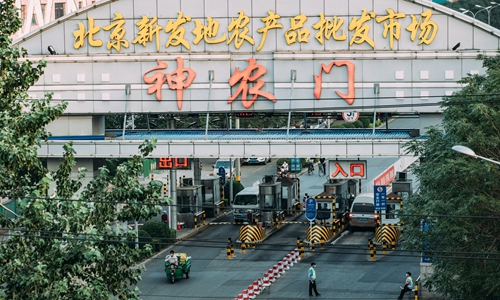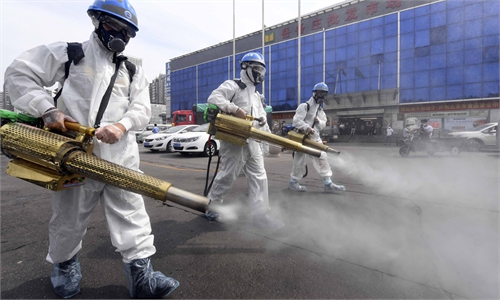SOURCE / INDUSTRIES
Beijing’s emergency response status upgraded to level 2, governments nationwide launch corresponding measures

Xinfadi wholesale market in Beijing Photo: Li Hao/GT
Beijing is reporting increasing numbers of COVID-19 cases - now double digits on a daily basis - which has led to an escalation of the city's emergency response status from level 3 to level 2. That has put other cities and provinces on alert, with tough measures implemented for those traveling from Beijing.Beijing's emergency response status was lowered to level 3 for just 10 days before being returned to level two. It is now the only region in the country with a level 2 response status.
The provincial government of Northeast China's Heilongjiang has launched one of the toughest corresponding measures, requiring those who visited or came in contact with people who visited Beijing wholesale markets and those with a history of travel to middle and high-risk areas to accept 14 days of centralized quarantine for medical observation, seven days of home quarantine for medical observation and four nucleic acid tests.
The provincial government also asked people to avoid traveling to Beijing unless necessary until the capital's outbreak stabilizes. Vehicle inspections have also been increased. Those coming from Beijing are encouraged to return to Beijing, and those traveling to Beijing for 12 hours or more are encouraged to remain in Beijing, according to the information office of Heilongjiang Province.
Southwest China's Yunnan Province says that those who have been to Beijing and had close contact with confirmed or suspected cases, or have symptoms such as fever, cough or shortness of breath will need to visit a fever clinic at a designated medical institution and undergo testing and medical observation at the earliest opportunity, according to the provincial government's report.
In addition, all persons returning to Yunnan from Beijing should cooperate with provincial health code scanning management.
All those with red codes or those traveling from high-risk areas should be quarantined for 14 days upon arrival in Yunnan, and nucleic acid and antibody tests should be conducted twice. Negative nucleic acid test results should also be provided within seven days for yellow-code carriers or those from middle-risk areas.
Northwest China's Shaanxi Province has also issued measures requiring those who have traveled to Beijing wholesale markets, as well as those coming from middle and high-risk areas, to be centrally quarantined for 14 days and undergo nucleic acid testing, according to the provincial health commission on Tuesday.
Similar measures were implemented in certain other regions including South China's Guangdong Province and Southwest China's Sichuan Province.
Shanghai on Tuesday issued a notice that all who enter to or return to Shanghai from high-risk regions of China will be subject to a 14-day quarantine and will undergo two nucleic acid tests. Beijing's Huaxiang subdistrict in Fengtai, where the Xinfadi wholesale market is located, is currently the only high-risk area in China.
At present, people traveling from Beijing to Wuhan, Central China's Hubei Province can enter the city if they have a health green code, and there is not yet any quarantine requirement.
Beijing reported 31 confirmed locally transmitted COVID-19 cases, three suspected cases and six asymptomatic infections between midnight on Monday and midnight on Tuesday, the Beijing Municipal Health Commission said on Wednesday. As of midnight on Tuesday, Beijing has reported a total of 557 confirmed locally transmitted COVID-19 cases and a total of 411 patients have been discharged from hospital.

